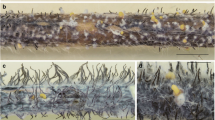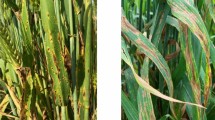Abstract
The genus Diaporthe Nitschke (Phomopsis Sacc. & Harter) infect various agricultural and horticultural important crops and cause diseases such as damping off, leaf spots, blights, canker, dieback, wilt, root and fruit rots. P. vexans, P. helianthi and P. phaseolorum are the important species within genus causing huge yield and economic loss. Being primarily seed borne it also hinders import and export of germplasm and seeds. Therefore, extensive characterization is required to diagnose and manage the disease. Seventeen isolates collected from ITCC, IARI and ICAR-NBPGR belonging to eight species were morphological and molecularly characterized and diversity was analyzed. Several morphological and cultural characters were studied and analyzed. Due to lack of sufficient morphological variation to identify/differentiate species, molecular characterization using house-keeping genes, internal transcriber spacer (ITS) was carried out. ITS produced amplicon of ~ 600 bp in the isolates of Phomopsis and phylogenetic tree obtained revealed that isolates of a species belonging same geographic region had more sequence similarity than isolates belonging to different geographic regions this might be due to population adaption under varied environments. Development of EF-1alpha-based marker specific to P. phaseolorum helps in easily detection of pathogen in quarantine stations. In addition, species of Phomopsis were previously named based on host association which has led to misidentification and proliferation of species. Cross pathogenicity of isolates on three important hosts, brinjal, soybean and chilli revealed its broad host range and naming only basis of host association is unjustified.









Similar content being viewed by others
References
Akhtar J, Chaube HS (2006) Variability in Phomopsis blight pathogen [Phomopsis vexans (Sacc. & Syd.) Harter]. Indian Phytopathol 59:439–444
Baumgartner K, Fujiyoshi PT, Travadon R, Castlebury LA, Wilcox WF, Rolshausen PE (2013) Characterization of species of Diaporthe from wood cankers of grape in eastern North American vineyards. Plant Dis 97:912–920
Chaisiri C, Liu XY, Lin Y, Li JB, Xiong B, Luo CX (2020) Phylogenetic analysis and development of molecular tool for detection of Diaporthe citri causing melanose disease of citrus. Plants 9:329
Chupp C, Sherf AF (1960) Vegetable diseases and their control. The Ronald press company, New York, p 693
Danggomen A, Visarathanonth N, Manoch L, Piasai O (2013) Morphological studies of endophytic and plant pathogenic Phomopsis liquidambaris and Diaporthe phaseolorum (P. phaseoli anamorph) from healthy plants and diseased fruits. Thailand J Agric Sci 46:157–164
Gomes RR, Glienke C, Videira SIR, Lombard L, Groenewald JZ, Crous PW (2013) Diaporthe: a genus of endophytic, saprobic and plant pathogenic fungi. Persoonia Mol Phylogeny Evolut Fungi 31:1
Hosseini B, El-Hasan A, Link T, Voegele RT (2020) Analysis of the species spectrum of the Diaporthe/Phomopsis complex in European soybean seeds. Mycol Prog 19:455–469
Ito T, Fuji S, Sato E, Iwadate Y, Toda T, Furuya H (2012) Detection of Phomopsis sclerotioides in commercial cucurbit field soil by nested time-release PCR. Plant Dis 96:515–521
Jamir M, Rajesh T, Devi RT, Majumder D, Ningthoujam K, Hemochandra L (2018) Cultural and morphological variability in Phomopsis vexans (Sacc. & Syd.) harter causing fruit rot of brinjal. Int J Curr Microbiol App Sci 7:2807–2814
Jayaramaiah KM, Mahadevakumar S, Raj AC, Janardhana GR (2013) PCR based detection of Phomopsis vexans (Sacc. & Syd.)-the causative agent of leaf blight and fruit rot disease of Brinjal (Solanum melongena L.). Int J Life Sci 7:17–20
Kucharek T (2001) Some common soybean leaf and stem diseases. Plant pathology fact sheet. University of Florida, Gainesville
Lombard L, Van Leeuwen GC, Guarnaccia V, Polizzi G, Van Rijswick PC, Rosendahl KC, Crous PW (2014) Diaporthe species associated with Vaccinium, with specific reference to Europe. Phytopathol Mediterr 53:287–299
Mahadevakumar S, Janardhana GR (2016) Leaf blight and fruit rot disease of brinjal caused by Diaporthe vexans (Phomopsis vexans) in six agro-ecological regions of south West India. Plant Pathol Quar 6:5–12
Mahadevakumar S, Amruthavalli C, Sridhar KR, Janardhana GR (2017) Prevalence, incidence and molecular characterization of Phomopsis vexans (Diaporthe vexans) causing leaf blight and fruit rot disease of brinjal in Karnataka (India). Plant Pathol Quar 7:29–46
Mathew FM, Alananbeh KM, Jordahl JG, Meyer SM, Castlebury LA, Gulya TJ, Markell SG (2015) Phomopsis stem canker: a reemerging threat to sunflower (Helianthus annuus) in the United States. Phytopathology 105:990–997
Mena E, Stewart S, Montesano M, Ponce de León I (2020) Soybean stem canker caused by Diaporthe caulivora; pathogen diversity, colonization process, and plant defense activation. Front Plant Sci 10:1733
Murray MG, Thompson WF (1980) Rapid isolation of high molecular weight plant DNA. Nucleic Acids Res 8:4321–4325
Pioli RN, Morandi EN, Martínez MC, Lucca F, Tozzini A, Bisaro V, Hopp HE (2003) Morphologic, molecular, and pathogenic characterization of Diaporthe phaseolorum variability in the core soybean-producing area of Argentina. Phytopathology 93:136–146
Piza MCP, Prevosto L, Zilli C, Cejas E, Kelly H, Balestrasse K (2018) Effects of non–thermal plasmas on seed-borne Diaporthe/Phomopsis complex and germination parameters of soybean seeds. Innov Food Sci Emerg Technol 49:82–91
Rohini GHG, Hariprasad P, Niranjana S (2016) Cultural, morphological and physiological characterization of Phomopsis vexans isolates from different brinjal (Solanum melongena L.) growing regions of Karnataka, India. Int J Curr Microbiol Appl Sci 7:70–77
Santos JM, Vrandečić K, Ćosić J, Duvnjak T, Phillips AJL (2011) Resolving the Diaporthe species occurring on soybean in Croatia. Persoonia Mol Phylogeny Evolut Fungi 27:9
Santos L, Phillips AJL, Crous PW, Alves A (2017) Diaporthe species on Rosaceae with descriptions of D. pyracanthae sp. nov. and D. malorum sp. nov. Mycosphere 8:485–511
Shirahatti PS, Ramu R, Purushothama CRA (2015) Development of a simple and reliable species-specific detection of Phomopsis azadirachtae, using the translation elongation factor 1-alpha gene. Eur J Plant Pathol 141:769–778
Shu C, Chen J, Huang H, He Y, Zhou E (2014) First report of Phomopsis longicolla causing stem canker of eggplant in Guangdong, China. Plant Dis 98:426–426
Sinclair JB (1993) Phomopsis seed decay of soybeans: a prototype for studying seed disease. Plant Dis 77:329–334
Thompson SM, Tan YP, Young AJ, Neate SM, Aitken EAB, Shivas RG (2011) Stem cankers on sunflower (Helianthus annuus) in Australia reveal a complex of pathogenic Diaporthe (Phomopsis) species. Persoonia Mol Phylogeny Evolut Fungi 27:80
Udayanga D, Liu X, McKenzie EH, Chukeatirote E, Bahkali AH, Hyde KD (2011) The genus Phomopsis: biology, applications, species concepts and names of common phytopathogens. Fungal Diversity 50:189
Udayanga D, Liu X, Crous PW, McKenzie EH, Chukeatirote E, Hyde KD (2012) A multi-locus phylogenetic evaluation of Diaporthe (Phomopsis). Fungal Diversity 56:157–171
Udayanga D, Castlebury LA, Rossman AY, Hyde KD (2014) Species limits in Diaporthe: molecular re-assessment of D. citri, D. cytosporella, D. foeniculina and D. rudis. Persoonia Mol Phylogeny Evolut Fungi 32:83
Udayanga D, Castlebury LA, Rossman AY, Chukeatirote E, Hyde KD (2015) The Diaporthe sojae species complex: phylogenetic re-assessment of pathogens associated with soybean, cucurbits and other field crops. Fungal Biol 119:383–407
Van Niekerk JM, Groenewald JZ, Farr DF, Fourie PH, Halleer F, Crous PW (2005) Reassessment of Phomopsis species on grapevines. Aust Plant Pathol 34:27–39
Van Rensburg JCJ, Lamprecht SC, Groenewald JZ, Castlebury LA, Crous PW (2006) Characterization of Phomopsis spp. associated with die-back of rooibos (Aspalathus linearis) in South Africa. Stud Mycol 55:65–74
Vrandecic K, Jurkovic D, Riccioni L, Cosic J, Duvnjak T (2010) Xanthium italicum, Xanthium strumarium and Arctium lappa as new hosts for Diaporthe helianthi. Mycopathologia 170:51–60
Walker JC (1952) Diseases of vegetable crops. McGraw-Hıll Book Company Inc., New York, pp 190–191
White TJ, Bruns T, Lee SJWT, Taylor JL (1990) Amplification and direct sequencing of fungal ribosomal RNA genes for phylogenetics. PCR Protocols Guide Methods Appl 18:315–322
Yang Q, Fan XL, Guarnaccia V, Tian CM (2018) High diversity of Diaporthe species associated with dieback diseases in China, with twelve new species described. MycoKeys 39:97
Zhang AW, Hartman GL, Riccioni L, Chen WD, Ma RZ, Pedersen WL (1997) using PCR to distuingusih Diaporthe phaseolorum and Phomopsis longicolla from other soybean fungal pathogens and to detect them in soybean tissues. Plant Dis 81:1143–1149
Acknowledgements
The authors are thankful to ITCC, ICAR-IARI, New Delhi and ICAR-NBPGR, New Delhi for providing Phomopsis cultures and also thank Division of vegetable science, ICAR-IARI and ICAR-NBPGR, New Delhi for proving seeds. The first author thanks ICAR for providing junior research fellowship.
Author information
Authors and Affiliations
Contributions
NK, SCD and DK were involved in designing objectives and experiment. NK did experimental work and data analysis. DK was involved in designing primers. NK and SCD wrote the paper.
Corresponding author
Ethics declarations
Conflict of interest
There was no conflict of interest among authors, co-authors and the institute where the work has been carried out.
Rights and permissions
About this article
Cite this article
K, N., Dubey, S.C. & Kamil, D. Diversity analysis of different Diaporthe (Phomopsis) species and development of molecular marker to identify quarantine important species Phomopsis phaseolorum. 3 Biotech 12, 31 (2022). https://doi.org/10.1007/s13205-021-03075-1
Received:
Accepted:
Published:
DOI: https://doi.org/10.1007/s13205-021-03075-1




